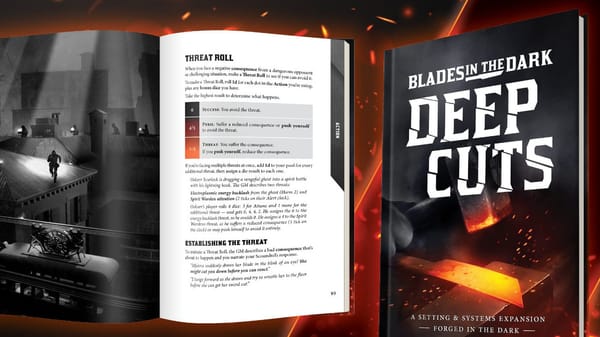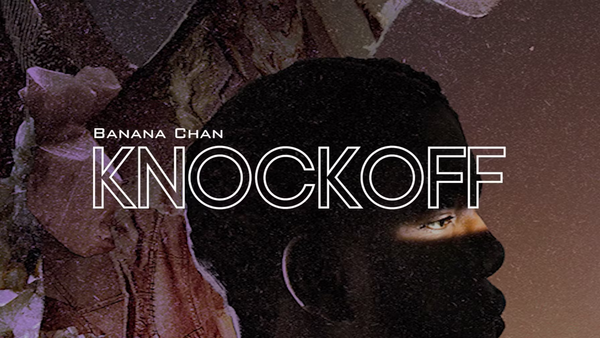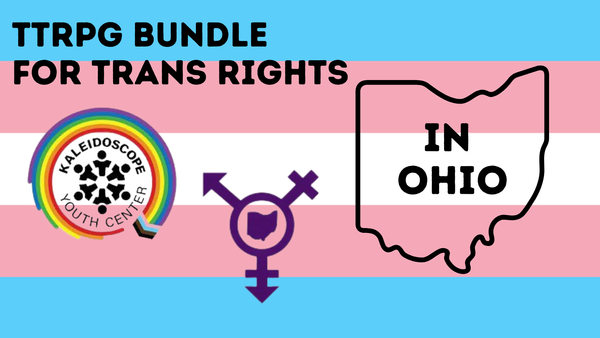But I don’t have any money: Actual Play and Porn
I’m so sorry, this never happens at my home game.

The cyclical comparison has returned: actual play is to tabletop as porn is to sex. The basis of the metaphor usually starts and ends on one primary philosophical pillar: actual play and porn are both unrealistic performances of an intimate experience. In some ways, this is true. The two mediums certainly share a lot in terms of form, performance, and audience desire for ever-elusive “authenticity.” A number of cross-pollinations have occurred between them from the early (and, for many reasons, forgotten) AP, I Hit It With My Ax and its cast of adult performers, to the contemporary Tabletopless, an actual play of “porn stars and cam models playing hardcore RPGs,” which can be found at what might be a perfectly named site, CriticalHole.com. I’d also agree that the most popular versions of actual play and porn have created a culture of mismatched expectations around TTRPGs and sex, respectively. And yes, as a teenager I did quickly close my tab when someone knocked on my door while I was watching actual play.
"Actual play is to tabletop as porn is to sex."
A wave of condemnations, disagreements and memes greeted game designer Grant Howitt’s tweeting out the most recent iteration of this comparison. Those in support of porn say it’s a fundamental misunderstanding of both mediums. Those who look down on sex work say it’s a crass comparison that undermines actual play, or use the metaphor as an intentionally derogatory statement. Those focused more on authenticity in either medium argue about the accuracy of performed play (in both senses of the word) to their off-camera equivalents. However, as discourse is wont to do, the conversation is usually limited to debating individual points. It reduces two expansive, complex, and multi-faceted art forms—yes, porn is an art form—to their most visible and commodifiable elements without considering the larger culture in which they both exist. Perhaps we can find commonalities between the two fields, and, in doing so, better understand and support both art forms in an increasingly hostile digital and political landscape.
Sex, like play, is a pleasurable but largely controversial part of being alive. Attempting to dictate a correct way to desire and provide pleasure has been a topic of political and social debate for… a very long time. Embracing that pleasure through personal gratification, artistic depiction, and/or marketable commodification are all manifestations of this attempt to control natural impulses; either through exploitation or radical reclamation.

Both porn and actual play are artistic interpretations of natural acts. Animals play just as much as they have sex—humans are just, tragically, the only species to think about why they do it and assign morality to how it’s done. The oldest form of pornographic art dates back nearly 35,000 years. At any point in time, in any culture, one can find an artistic representation of people getting it on. The same can be said about games. Actual play in its current form is a bit younger, coming in at just under two decades—but Japanese replays and written actual plays on forums like The Forge, as described by TTRPG historian Evan Torner, have a longer heritage. Though not comparable to porn in any recognizable fashion, these reports were meant to offer game designers opportunities to relay player experiences for comparison and critical development, not dissimilar to a group of friends comparing notes on their recent night out at the club. Or maybe, more accurately, discussions between sex workers talking through best practices.
There are variations of style even among contemporary productions of both porn and actual play. The most well-funded programs in both mediums are studio productions performed by professionals attempting to evoke a specific consumable experience. They often edit out the awkward, clumsy—and, to many, unentertaining—elements found in more casual and private play, whether that’s searching for rules during a crunchy combat encounter and stumbling over words or suffering a cramp and failing to “get it up.” In other forms of AP and porn, “amateurs” pursuing performed play as a secondary source of income or as a hobby create less-produced versions, meant to represent a more “authentic” one-to-one depiction of the unfilmed act. In AP podcasts and on erotica platforms like Quinn, audio programs sell a consumable performance without any visuals, entirely intended to evoke a mental experience. Arguably the highest quantity of both porn and actual play created are remote experiences captured entirely via webcam or phone.
"Both porn and actual play are artistic interpretations of natural acts."
Regardless of format, creators and consumers should understand that both porn and APs are a product. For the audience seeking these forms of entertainment, there are a range of stylistic preferences that each provide unique experiences. Some are there for the fantasy, preferring a fiction that has little to do with the people on screen and only focuses on creating a polished entertainment product for the person watching. This includes those who watch porn “for the story,” or for the artform, or simply for a momentary distraction; while actual play audiences look for a narrative akin to watching a film or TV show.
Many who enjoy either medium are looking for a representation of play or sex they deem realistic. Authenticity is elusive; it has no real defining feature other than—as Supreme Court Justice Potter Stewart said when defining “hard-core” pornography—“I know it when I see it.” Whether performing in an actual play or porn is the same act as it would be off-camera varies from person to person, and is largely up to individual process and preference. Some do not change their behavior whatsoever, some settle into play as they become more comfortable, while others turn on (in every sense of the word) in front of an audience. And when it comes to both tabletop and sex, unless you're playing solo, there’s always an audience. In my opinion, it’s far less interesting to consider whether or not what happens in front of the camera in either medium is accurate to an off-camera act, but instead why audiences desire authenticity in the first place.

Fans of a more “authentic” style want to witness two or more people sharing space and vulnerability with one another, a voyeuristic vantage point on a private act. In porn, this perception of authenticity offers physical, sexual, and emotional stimulation that supplements or replaces intimacy in one’s life. In actual play, there is a sense that the people playing are close to one another, just friends at a table. The audience by extension is gaining access to that sense of community and a living creative experience. Audiences of both porn and AP follow the careers of real people, having developed a bond with a performer’s persona or their style of performance. Many viewers will pay for what they perceive as access to these individuals, given privileges such as content made with their preferences in mind or direct communication in exchange for their patronage. In an era of increased social isolation and loneliness, it’s unsurprising that people wish to find opportunities for pleasurable interpersonal connection, even vicariously. To be clear, this isn’t a negative—simply a logical result of an increasingly alienating world.
For those adamant that neither porn nor actual play are “authentic” depictions of their private counterparts, why is it so important that the people on screen accurately reflect one’s preferred method of play? Seeking validation and representation in the media we consume affirms our insecurities that we are “doing it right” whether that be roleplay or roleplay, two immensely vulnerable and awkward experiences that, when uninhibited by self-criticism, give way to immense joy and satisfaction. However, just because one creator’s style of performance doesn’t align with our preference doesn’t mean either party is partaking in the act incorrectly. The only wrong way to play a game or have sex is to do it nonconsensually or without concern for an involved member’s enjoyment.
"When it comes to both tabletop and sex, unless you're playing solo, there’s always an audience."
There are some creators who participate in these mediums solely out of pleasure. Some enjoy rolling dice and playing pretend, while others just like to get railed and feel sexually desirable. Many practitioners do it out of necessity as one of the only ways they can capitalize on skills in a world that has fetishized identity as something to be consumed for entertainment. This is a classic story of survival sex work, especially among people of marginalized identities (look up “chasers” after you finish reading this). While actual play isn’t an inherently lucrative path, many find it a fulfilling part of their artistic portfolio.

More still create, in either medium, to challenge broader cultural understanding of their chosen subject matter—be that sex, gender, race, body size, disability, or religious and political institutions. In porn, that often comes through confronting the male gaze, an oft mis-quoted film theory which places the camera as an extension of a masculine viewer’s perspective on the subject. It has frequently been used to reduce femme people into a passive object to be desired and conquered, which is then multiplied by intersectional oppression. In tabletop, radical reinvention involves telling stories that center people and themes unable to find homes in traditional entertainment mediums. Though the methods of overcoming these taboos come from ideologically similar roots, their consequences are vastly different.
Venturing past the surface level comparisons of form to the social conditions underlying the creation of porn and AP, the metaphor begins to fall apart under the scrutiny of our puritanical, patriarchal society. In many ways, discovering that someone has engaged in sex work is a social death sentence, most often for a femme identifying person. Unless, that is, they are a female celebrity who fits Western standards of beauty, in which case that sexuality is both condemned and consumed, a la Kim Kardashian’s sex tape and The Fappening of 2014 (in which hundreds of celebrities' private photos were leaked to the internet).
While playing tabletop games was viewed as a social taboo for many years and caused social conflict among more conservative portions of society—especially during the era of Satanic Panic—no one has ever released revenge recordings of someone playing Dungeons & Dragons. There has likely been no Footloose-style town where Matt Mercer had to convince all the local teens to play D&D in someone's barn. However, even among the fandoms of actual play, prominent women are often sexualized and demonized in the same breath, which can be seen in Reddit threads discussing popular actual play performers like Marisha Ray (Critical Role) or Emily Axford (Dimension 20)—while similar play styles from their male counterparts are generally heralded. Still, recent years have seen parallel evolutions in the cultural acceptance of all genders in both sex work and tabletop.

Both mediums have a vibrant community of marginalized creators who have been creating subversive, liberatory art that questions the larger status quo. A growing number of practitioners in these forms understand that their artistic depictions of these acts reinforce or subvert established expectations of who is allowed to be on screen and have agency, and what the act of play looks like. With that increased awareness has come a divergence of who takes that as a responsibility in their own work, and who dismisses it as prohibitively restrictive on the content they produce. Still, intimacy coordination and scene negotiation prior to production have become commonplace in both forms, as safeguards against potentially traumatic experiences that can arise in either arena. The consequences of not doing so in tabletop might create emotionally toxic situations for players and GMs, while in porn the consequences can lead to real physical and sexual violence.
Adult performers are often stereotyped as being poor, exploited women, failed actors, or aspiring actors doomed to failure. The latter is often said about actual play performers as well. While these broad generalizations may have a kernel of truth, there is no question that porn has become a thriving industry that many are choosing to enter, and actual play is in the early stages of becoming a fully-fledged entertainment subsector. ‘Get your bag’ has become a common refrain for those venturing into the world of OnlyFans, while actual players are increasingly leveraging social media followings to garner sponsorships and financial opportunities. Not to mention there are a significant number of practitioners who participate in both fields, some keeping the two separate while others use one audience to fuel the other. Performers in both understand their value as sources of capital, and rather than allow themselves to be exploited at the whims of power-hungry producers, what unites the two ideologically is a large movement towards safer, more inclusive, worker-focused industries.
"More still create, in either medium, to challenge broader cultural understanding of their chosen subject matter—be that sex, gender, race, body size, disability, or religious and political institutions."
There is a strong ecosystem of practitioners in both fields who collaborate in one another’s content for personal or professional reasons, such as safety or social capital. In self-produced sectors where money does not come as abundantly, performers of both industries frequently support one another through knowledge sharing and mutual aid. This need for communal care comes from a larger political issue that impacts porn in ways it does not impact actual play performers: criminalization.
While the porn industry is regulated in many ways, sex work is largely an illegal act. Around the globe, people in the adult entertainment industry are prevented from any stability in their livelihood or general safety. Organizing a house of actual players or hiring security for your live show will not have your home deemed a brothel, nor will Mastercard, Venmo, Paypal, or other financial institutions prevent you from taking payments as they do with sexual content. Adult performers and creators are dismissed as morally corrupt individuals tempting pure, honest, hard working citizens; while simultaneously being a hidden pleasure for the very same people creating legislation to penalize those creating it. Legislation like SESTA-FOSTA, which is allegedly designed to protect victims of sex trafficking but in reality endangers the livelihood of sex workers. Actual players rarely have the morality of their art form questioned and never face criminal repercussions for their work. There are many similarities in the forms of both actual play and porn, but the socio-economic foundations beneath them are vastly different in ways that are fruitful to dissect.
Exploring the ways we as humans find pleasure through shared intimacy and deconstructing power in a controlled space is imperative to understanding ourselves and the culture we live in. There are a dozen essays to be written about the overlaps of tabletop gaming, sex, kink, and porn. Comparing actual play to porn isn’t a totally incorrect metaphor, but it shouldn’t be a condemnation of actual play or sex work. It should be a call for those of us in the TTRPG ecosystem to find solidarity and common ground with artists in parallel fields, and, possibly, in horizontal positions.
If you enjoyed this article, please consider sharing it with a friend. As an extra incentive, and as a thank you for supporting us, feel free to gift two weeks of Rascal using this link.





